Mission Statement
The efficient analysis and representation of person-related information is one of the most important challenges for human social perception. Faces, for instance, inform us about a large variety of socially relevant information including a person´s identity, emotions, gender, age, ethnic background or focus of attention. Cognitive models of face perception acknowledge a degree of functional independence between these different aspects of perception, each of which may be mediated by different types of “diagnostic” information in the stimulus. Cognitive neuroscience is beginning to reveal the neural mechanisms that underlie face perception, but there has been little work on integrating those data with models from cognitive and social psychology. The present applicants have begun to successfully collaborate on this integrative view. In this Research Unit, we will combine a multilevel methodological approach to promote a unified theory of the psychological and neural bases of person perception. In a closely coordinated research programme, we will investigate i) basic perceptual processes, ii) the processing of social and emotional information about people, and iii) person perception in specific populations.
Examining the transient effects of previous experience with faces has been particularly influential for cognitive models of face perception. While research on priming, and more recently on adaptation, is shaping theories about the neural mechanisms and representations involved in various aspects of face perception, the precise relationship between these two phenomena remains to be determined. A highly relevant open issue is face learning – the question how perceptual and neural mechanisms create stable representations for initially unfamiliar faces. The voice – which carries a wealth of nonverbal social information similar to faces – has received little scientific attention in the past. Current research thus needs to reflect the importance of auditory person perception. Dynamic multimodal information from faces and voices is often combined to shape our perception of identity or social group membership (e.g., gender, ethnicity, region). Faces and voices also can be highly potent emotional stimuli which may be processed even in the absence of attention. Moreover, people differ in physical attractiveness, a powerful variable for sexual partner preference. Person perception and memory for elderly people may become more prevalent in the future as a result of demographic changes. Finally, dramatic impairments in person perception can occur in specific conditions such as congenital prosopagnosia, an inability to identify faces of familiar people.







